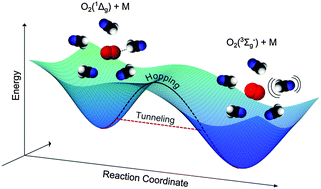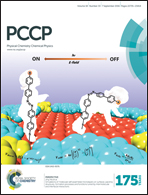Solvent-dependent singlet oxygen lifetimes: temperature effects implicate tunneling and charge-transfer interactions†
Abstract
The effect of solvent on the lifetime of singlet oxygen, O2(a1Δg), particularly the pronounced H/D solvent isotope effect, has drawn the attention of chemists for almost 50 years. The currently accepted model for this phenomenon is built on a foundation in which the electronic excitation energy of O2(a1Δg) is transferred to vibrational modes in a solvent molecule, with oxygen returning to its ground electronic state, O2(X3Σg−). This model of electronic-to-vibrational (e-to-v) energy transfer specifically focusses on the solvent as a “sink” for the excitation energy of O2(a1Δg). On the basis of temperature-dependent changes in the solvent-mediated O2(a1Δg) lifetime, we demonstrate that this energy-sink-based model has limitations and needs to be re-formulated. We now show that the effect of solvent on the O2(a1Δg) lifetime is more reasonably interpreted by considering an activation barrier that reflects the extent to which a solvent molecule perturbs the forbidden O2(a1Δg) → O2(X3Σg−) transition. For a given solvent molecule, this barrier reflects contributions from (a) the oxygen-solvent charge transfer state that mediates nonradiative coupling between the O2(a1Δg) and O2(X3Σg−) states, and (b) vibrations of specific bonds in the solvent molecule. The latter establishes connectivity to the desirable features of the energy-sink-based model. Moreover, temperature-dependent H/D solvent isotope effects imply that tunneling through this barrier plays a role in the mechanism for O2(a1Δg) deactivation, even at room temperature. Although we focus on a long-standing problem involving O2(a1Δg), our results and interpretation touch fundamental issues of interest to chemists at large.


 Please wait while we load your content...
Please wait while we load your content...